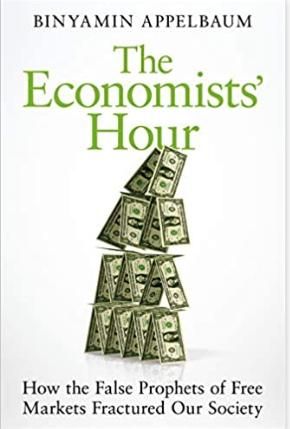New York Times editorial writer Binyamin Appelbaum delves deep into the histories and philosophies of influential economists to see how their ideas have shaped the American economy.

Economic Theory Vs. Real Life
In this insightful study of post-World War II economic orthodoxy, editorial writer Binyamin Appelbaum details how economists Milton Friedman, Arthur Laffer and other free market proponents captured the imaginations of Ronald Reagan, Margaret Thatcher and other world leaders. The results, Appelbaum writes, were lower taxes for the wealthy and falling incomes for everyone else. His far-ranging analysis will engage readers of all political and economic stripes, who will find Appelbaum’s treatise a sobering take on the modern economy.
This Wall Street Journal bestseller earned the Porchlight Business Book Award in Narrative and Biography. The Economist called it “a well-reported and researched history of the ways in which plucky economists helped rewrite policy in America and Europe and across emerging markets.” The New Republic wrote that Appelbaum “shows economists’ dramatic impact on government policy, and thus reveals economics to be not an abstract, disinterested science but a moral and political science all to itself.”
Free Market Theories
Appelbaum details how the US economy boomed after World War II and how policy makers regulated commerce with little regard for economic theory. But when the boom ended, economists – most famously, Milton Friedman and Arthur Laffer – proselytized against government intervention, urging politicians to open up markets, lower taxes and neuter regulations.
These free market acolytes, Appelbaum asserts, oversold the revolution. He reveals that US economic growth has slowed steadily, from more than 3% annually in the 1960s to less than 1% in the 2000s.
Markets and Government Intervention
Appelbaum describes how the influence of the Chicago school of economics, which originated at the University of Chicago, grew. Its proponents, he stresses, support markets above all and eschew government involvement in the economy.
Milton Friedman skittered disruptively through the 20th century like a loose electron, leaving behind a world reconfigured by his ideas.Binyamin Appelbaum
Appelbaum characterizes Milton Friedman as the most influential economist in this group. Appelbaum learned, for example, that Friedman argued in his dissertation that licensing physicians contributed to harmful government restraint of free markets. By 1956, the author recounts, Friedman had criticized public housing, national parks, the postal service and forced military service, all of which he regarded as government overreach.
Stagflation
Appelbaum explains that Keynesian economics holds that joblessness and inflation can’t rise at the same time. Yet, the author reports, that’s exactly what happened during the 1970s period of stagflation. Unemployment increased due to weak economic demand; prices soared because US and European governments kept churning out money.
President Jimmy Carter, Appelbaum relates, appointed the inflation-fighting Paul Volcker to run the Federal Reserve. When the government constrained the money supply, interest rates rocketed past 20%. Appelbaum notes that, as consumers ceased consuming, unemployment climbed, reaching, for example, 23% in the automobile sector and 29% in the steel industry.
Reagan was willing to accept the pain required by the monetarist approach.Binyamin Appelbaum
Appelbaum stresses that when Ronald Reagan arrived at the White House in 1981, he targeted the US government as responsible for soaring prices and a moribund economy. Appelbaum tells how UK prime minister Margaret Thatcher likewise chose high unemployment over inflation. The author presents Fed chairman Alan Greenspan telling the US Congress in 1994 that restrained inflation would prevent companies from relying on price increases to grow revenues; instead, they would ferret out inefficiencies to fuel greater productivity. Appelbaum relates how Greenspan said in private that he had no proof to back up his assertion.
Big Corporations
Appelbaum cites University of Chicago faculty member George Stigler, who influentially argued that companies rarely colluded to set prices and that corporate consolidation was not inherently bad. Appelbaum shows how Stigler’s criticism of antitrust regulation found a home in the Reagan administration. Reagan halved his antitrust department staff, and the Federal Trade Commission, the author reports, approved mergers of record size and ended inquiries into the anticompetitive behavior of automakers, oil giants and makers of breakfast cereal. Appelbaum details how, under presidents Clinton, Bush and Obama, airlines, car rental companies and beer brewers consolidated relentlessly. And since then, he laments, the biggest share of profits have gone to a small coterie of executives, not to workers.
US Factory Workers
According to Appelbaum, Friedman, a strong proponent of free trade, argued that if China sold goods to US consumers at better prices than American companies could, the US economy would benefit. Appelbaum contends that Friedman did not foresee the impact on US workers when global manufacturing moved from the Rust Belt to China.
The market economy remains one of humankind’s most awesome inventions, a powerful machine for the creation of wealth. But the measure of a society is the quality of life at the bottom of the pyramid, not the top.Binyamin Appelbaum
Appelbaum presents, among others, the story of blue-collar worker George Carney as exemplifying the costs of globalization. Carney lost his job in a refrigerator factory in 2004. More than a decade later, the author reveals, Carney remained unemployed, surviving on disability benefits.
A Delicate Balance
Appelbaum walks a narrow path in this highly readable history. On the one hand, he must satisfy financial professionals with his grasp of each nuance of the cited economists’ philosophies and outlooks. On the other hand, Appelbaum must present this story so that noneconomists can read it without nodding off and so gain a more profound understanding of the science, values and events that shape the global economy. That’s no easy feat, but Appelbaum pulls it off. He writes in a plain, unadorned prose style that conveys complex information clearly, and he remembers to include plenty of petty feuds and personality battles to engage lay readers.
Other worthy reads on economics and its interaction with US politics include Policy and Choice by William E. Congdon, Jeffrey R. Kling and Sendhil Mullainathan; Money and Government by Robert Skidelsky; and The Great Reversal by Thomas Philippon.





